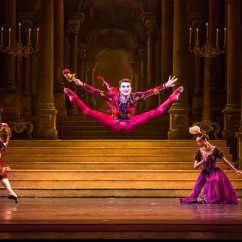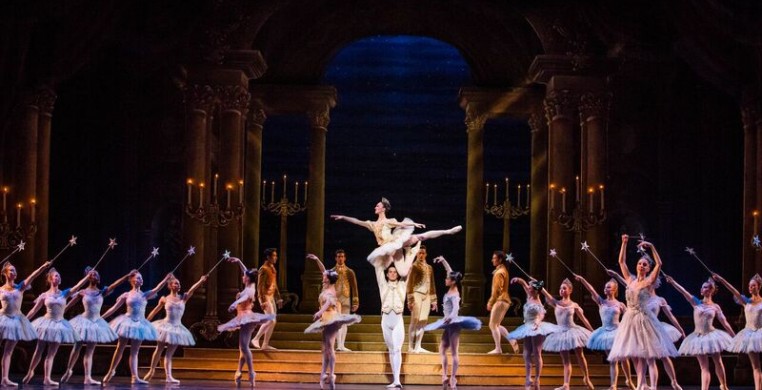Joffrey Ballet’s lavish production of Frederick Ashton’s Cinderella (Auditorium Theater, May 11-22) is a gift of classical ballet on its grandest scale, but with a stroke of modernity, a glittering finish to the company’s sixtieth anniversary season.
Realism and fantasy, modernity and classicism live side-by-side in this production, adding depth that makes it much more accessible to a diverse range of audience age and taste. Prokofiev’s haunting score is a prime example, combining dissonance with rich, flowing melodies, contrapuntal rhythms, and brass motifs with ominous anticipation of the age of anxiety looming in the near future. The music, performed to perfection by the Chicago Philharmonic Orchestra under the direction of Scott Speck, far more than mere accompaniment, is integral to the overall storytelling.
David Walker’s magnificent scenery is another example of this blend, detailed, complex, and soaring, with multiple scrims, visually-integrated legs, and multi-level exits. From the cavernous vaulted cellar of Cinderella's father's manor house to the sumptuous halls of the pillared palace, it creates once-upon-a-time landscapes of the imagination that transport the audience into the story’s fairytale world, while keeping its design firmly in the land of period realism. Walker’s delicious palette of period costuming is strictly on the classical spectrum, complete with frothy ballerina tutus and men’s velvet and brocade waistcoats.
Ashton’s liberties with classical form, choreographed in 1948, include spicy footwork and a modern geometry of spatial configurations for small ensemble and corps de ballet. The sequences in Act I for the Fairies of the Four Seasons and their corps de ballet Stars dazzle with especially diabolical combinations that do double duty as a showcase for each ballerina’s technical facility and style, while spinning the magic that transforms a pumpkin into a coach-and- four version of a luxury sedan, and poor Cinderella into a princess dressed in spun sugar. Anastacia Holden’s crisp emboitées as The Fairy Spring, Anais Bueno’s double piqué turns as Fairy Summer, Nicole Ciapponi’s full-range Fairy Autumn, and Jeraldine Mendoza’s fouetté arabesques en pointe lit the stage with their fairy fireworks.
April Daly’s Fairy Godmother combined the etherial lightness of a celestial being with the nurturing comfort of a mother, a glow of warmth and love emanating from her core that transforms time and space with a heavenly port de bras and absolutely luscious dancing. April Daly
April Daly
In Act II, Ashton spices up Prokofiev’s driven ballroom waltz with choreographic surprises and variations on court dances that depart from the classical canon and couple compellingly with the eery sense of pressing time in the music.
Ashton’s emphasis on comic relief for the Stepsisters, rather than as moral reference point for ethical instruction, made the medicine go down with a spoonful of sugar. On opening night, David Gombert and Rory Hohenstein made much fun of the buffoonery in Ashton’s rendering of the British tradition of “panto,” a form of theatrical farce characterized by slapstick comedy and gender-crossing actors. One hopes that their ferocious efforts to be funny and the grotesquerie of their gestures will mellow with a deeper grounding in the dramatic needs of these characters who, like all clowns, are funniest when they take themselves with utmost seriousness.  David Gombert and Rory Hohenstein
David Gombert and Rory Hohenstein
Ashton also borrowed the fairytale convention of beauty and goodness (the Fairy Godmother) concealed in the form of a haggard old beggar woman, providing the story with the test which leads to reversal of fortune and redemption for the persecuted Cinderella. The self-involved Stepsisters shun the hag, while Cinderella earns her reward by giving the woman bread, demonstrating her compassion and charitable nature.
Opening night saw a radiant Victoria Jaiani as Cinderella, refreshingly winsome in her portrayal of unaffected youth, dancing for the sheer joy of it in Act I, and with brilliant technical command of Ashton’s fiendishly demanding choreography in Act II. From cinders and rags to stunning white tutu and tiara, Jaiani’s Cinderella remained first and always faithful to her character’s virtue, open-hearted spirit and loving nature. A ballerina of extraordinary dramatic sensibility and discretion, Jaiani’s technical virtuosity never threatened to overshadow the storytelling, but rather, only enhanced its magic. Victoria Jaiani
Victoria Jaiani
Ashton’s Jester is master of ceremonies for Act II, giving opening night’s Derrick Agnoletti spectacular sequences of high-energy petit-allegro beats, brisées, split leaps, double tours, and countless pirouettes. Agnoletti’s coy clown is in love with fun, and he plays the jester with eye-popping elevation. The tricks up his sleeve are the springs in his legs.  Derrick Agnoletti
Derrick Agnoletti
Dylan Gutierrez’s Prince was the model of royal elegance, his musicality and spot-on technique especially striking.  Dylan Gutierrez and Victoria Jaiani
His lush, up-tempo pas de deux with Cinderella accelerates to a midnight drama of the missing girl. Trombones sound the hour of doom, and he is left to find her sparkling shoe on the palace steps. As a giant clock inundates the stage, we see a frantic Cinderella, back in her rags, rushing past Time. In true fairytale fashion, Joffrey’s Cinderella concludes with love and goodness triumphing. In the end, of course, the shoe fits the right girl, and sparkling fairy dust rains down on the united couple, to their enchantment, and ours.
Dylan Gutierrez and Victoria Jaiani
His lush, up-tempo pas de deux with Cinderella accelerates to a midnight drama of the missing girl. Trombones sound the hour of doom, and he is left to find her sparkling shoe on the palace steps. As a giant clock inundates the stage, we see a frantic Cinderella, back in her rags, rushing past Time. In true fairytale fashion, Joffrey’s Cinderella concludes with love and goodness triumphing. In the end, of course, the shoe fits the right girl, and sparkling fairy dust rains down on the united couple, to their enchantment, and ours. The Shoe Fits
The Shoe Fits
 Dylan Gutierrez and Victoria Jaiani
Dylan Gutierrez and Victoria Jaiani

